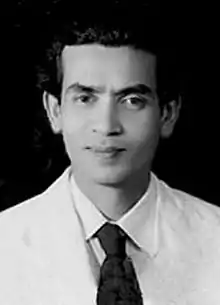Gunasena Galappatty
Gunasena Galappatty (born June 7, 1927, in Dikwella in Matara, Sri Lanka) was a Sri Lankan dramatist, director, producer, and Sinhala radio play writer regarded as the pioneer of suspense drama in Sri Lanka.[1]
Gunasena Galappatty | |
|---|---|
 | |
| Born | June 7, 1927 |
| Died | November 27, 1984 (aged 57) |
| Nationality | Sri Lankan |
| Education | Dikwella Central College, Rahula College Matara, University of Ceylon, University of Peradeniya, Yale University |
| Occupation(s) | Stage director, Teacher, Translator |
| Spouse | Sumana Abeysinghe |
| Children | Deepthi Sagarika Galappatty, Chanakya TharangaGalappatty, Sampath Galappatty |
Education
Galappatty attended Dikwella Central College and Matara Rahula College. In 1952, he entered University of Ceylon, Peradeniya campus, to study for a bachelor's degree in economics. At Peradeniya, he started associating with Professor Ediriweera Sarachchandra and Charles Silva and was involved in theatre work.
His first production was a folk drama Sandakinduru in 1957[2] in which he blended folk drama with modern Sinhalese music. This was a success and he was awarded a Fulbright Scholarship to study experimental theatre at Yale University, United States.
He was a teacher at Kotte Ananda Sastralaya in 1955 and next joined for a while the State Language Department as a translator, again continuing as a teacher.[3]
Career
From Yale, he went to Broadway in 1959, the first Sri Lankan to work there as well as in off-Broadway productions. During this time, he came under the influence of the Method school, the American offshoot of Konstantin Stanislavski's approach to acting and stagecraft. He worked under two distinguished teachers, Herbert Berghoff and Uta Hagen. He acted in and co-produced two Broadway dramas, Tea House of the August Moon and The Marriage-Go-Round.
He then traveled to many countries, including Spain, Japan and Russia, to study various drama styles and methods. He admired Spain's Federico García Lorca and spent a few weeks experiencing Lorca productions such as Yerma. In Japan, he studied traditional kabuki drama and was involved in a popular production, The Father.
Returning to Sri Lanka in 1961, Galappatty resumed his theatre work. Abandoning the operatic form modelled on Charles Silva and Sarachhandra crystallization of the Nadagam, he branched out on a new line which tried to fuse the inner-directed acting style that he had imbibed in Broadway with the non-naturalistic native tradition. In 1962, he produced a milestone in Sri Lankan theatre, Muduputtu (Sons of the Seas), showing that the traditional stylistic theatre could be blended very effectively with western realistic technique. Following this, he was at the forefront of Sri Lankan theatre and his productions launched the careers of many talented actors. He was called upon to represent Sri Lanka at United Nations conferences and other international activities.
Produced plays
|
|
Screen play
- 1972 Desa Nisa
Radio play
- 1963 Kali Yakinna
References
- "Gunasena Galappatty, was one of the greatest dramatists". hirdeyesouthasia.
- "Sandakinduru: Reviving folk melodies and dance". The Sunday Times (Sri Lanka). Retrieved 2 September 2010.
- "Jayalal Rohana: A man of many parts". The Sunday Times (Sri Lanka).
- "Returns to cinema after a sojourn". Sunday Observer. Archived from the original on 2010-08-21. Retrieved 2011-01-07.
- "Enthralling young minds". The Nation.
- "Dhamma Jagoda remembered". Island. - "Science College doing great things -Multi-talented". The Sunday Leader.
- "Malini Fonseka - from stage to screen". Daily News. Archived from the original on 2012-10-18. Retrieved 2011-01-07.